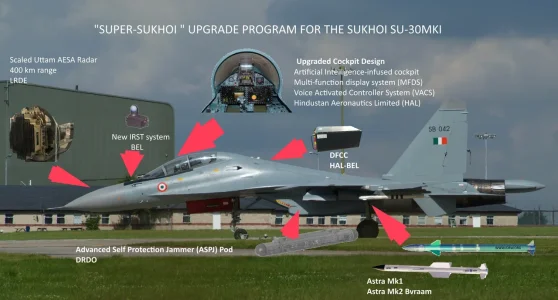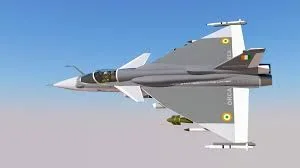- Joined
- Jul 8, 2024
- Messages
- 1,966
- Likes
- 13,763
I feel that the IAF should look to the following to boost squadron numbers and retain it's technological edge:
HAL feels confident enough to provide upgrades to the AL 31F and targets an increase of indigenization to 63% although Russia is against the same and may withdraw warranty support for these modified engines.
Super Sukhoi upgrades such as the new Virupaksha radar (2000+ TR GaN AESA), EW, cockpit, HMDS, SPJ, uprated engines (service life) will ensure that these fighter jets will pack a punch during a two front war.
India has recently signed on for 12 more Su 30 MKIs and 240 AL 31F engines. This number must be increased substantially moving forward.

Indigenous production of GE F414 (98 KN) would ensure less supply bottlenecks for the Tejas MK 2 and AMCA program. A 5th generation engine development plan would take at least 10 years to execute with either UK/France nd 5-8 years with massive concessions with US and Russia if signed in 2025.
Given the price considerations, an uprated F414 ( F414 Enhanced Engine) with 110 KN thrust may be used for the AMCA after the first 2-3 squadrons. A Tejas MK2A variant with these engines is also possible.

There is news that a 29 KN 'Afterburner Thrust' variant of the Kaveri engine is under development/ fabrication with BrahMos aerospace.
Increased funding and rapid trials and flight testing will allow the ~80 KN thrust variant to be ready by 2030 for use with the 97 Tejas MK1A to be produced by HAL. This will allow for less reliance on US for the GE F404 engine, an older design that the US isn't much focused on at the moment.
As an interim measure, older GE F404 102/103 engines will be used as substitutes for delivery to IAF and then at MROs the engine swap to the GE F404 IN20 will take place as available.
The Tejas MK2 IOC variant should be ready by 2029 and AMCA IOC variant should be ready by 2033. Induction of the Tejas MK2 by 2030 to complement and gradually replace the 40 year old Mig 29 and Mirage 2000 without reducing squadron numbers is a targeted possibility.
The AMCA would join the IAF in 2034 and then by late 2030s would rapidly plug the 'high end' gap in IAF's force spectrum.

Russia has offered the Su 57 multiple times however concerns with the stealth capabilities (RCS of a clean F/A-18E/F = 0.1 m^2) and manufacturing bottlenecks faced by Sukhoi to meet the RuAF's domestic requirement forecloses this option.
The Su 57 is still testing stealthy 2D TVC vanes (F 22 has been in service with the same for 20+ years) and HMDs which means that it is at best in IOC configuration.

That leaves the F 35 for consideration and the US under Trump may offer the same to India like it did in 2018. A limited number of aircraft 36-40 could provide a fig leaf of power balance against China and Pakistan and allow time for the AMCA to be fielded in significant numbers with the IAF.


That leaves the other G7+1 powers to start independent development of a 6th generation fighter program. In a case of history repeating itself, Italy-UK-Japan have joined forces under the GCAP (Global Combat Air Programme), similar to the Eurofighter project and France-Germany-Spain under the FCAS (Future Combat Air System), similar to the Rafale.
India being a signatory to either grouping would give us a huge advantage by the late 2030s and accelerate our aviation industry by decades. Conversely AMCA MK2 might be an incremental upgrade due to split funding priorities and a separate engine development deal with France would be unlikely.
However India must decide quickly as other suitors like South Korea, UAE and Saudi Arabia are waiting in line. An opportunity like this never knocks twice.
- Induct more Su 30 MKIs :
HAL feels confident enough to provide upgrades to the AL 31F and targets an increase of indigenization to 63% although Russia is against the same and may withdraw warranty support for these modified engines.
Super Sukhoi upgrades such as the new Virupaksha radar (2000+ TR GaN AESA), EW, cockpit, HMDS, SPJ, uprated engines (service life) will ensure that these fighter jets will pack a punch during a two front war.
India has recently signed on for 12 more Su 30 MKIs and 240 AL 31F engines. This number must be increased substantially moving forward.

- Work with GE to expedite GE F414 deal for licensed production :
Indigenous production of GE F414 (98 KN) would ensure less supply bottlenecks for the Tejas MK 2 and AMCA program. A 5th generation engine development plan would take at least 10 years to execute with either UK/France nd 5-8 years with massive concessions with US and Russia if signed in 2025.
Given the price considerations, an uprated F414 ( F414 Enhanced Engine) with 110 KN thrust may be used for the AMCA after the first 2-3 squadrons. A Tejas MK2A variant with these engines is also possible.

- Increase funding and proceed with rapid flight testing of Kaveri engine :
There is news that a 29 KN 'Afterburner Thrust' variant of the Kaveri engine is under development/ fabrication with BrahMos aerospace.
Increased funding and rapid trials and flight testing will allow the ~80 KN thrust variant to be ready by 2030 for use with the 97 Tejas MK1A to be produced by HAL. This will allow for less reliance on US for the GE F404 engine, an older design that the US isn't much focused on at the moment.
- Expedite the production process for the Tejas MK1A :
As an interim measure, older GE F404 102/103 engines will be used as substitutes for delivery to IAF and then at MROs the engine swap to the GE F404 IN20 will take place as available.
- Prototyping of AMCA and Tejas MK2
The Tejas MK2 IOC variant should be ready by 2029 and AMCA IOC variant should be ready by 2033. Induction of the Tejas MK2 by 2030 to complement and gradually replace the 40 year old Mig 29 and Mirage 2000 without reducing squadron numbers is a targeted possibility.
The AMCA would join the IAF in 2034 and then by late 2030s would rapidly plug the 'high end' gap in IAF's force spectrum.

- Bargain with US and Russia for 5th generation fighter aircraft as a stopgap
Russia has offered the Su 57 multiple times however concerns with the stealth capabilities (RCS of a clean F/A-18E/F = 0.1 m^2) and manufacturing bottlenecks faced by Sukhoi to meet the RuAF's domestic requirement forecloses this option.
The Su 57 is still testing stealthy 2D TVC vanes (F 22 has been in service with the same for 20+ years) and HMDs which means that it is at best in IOC configuration.

That leaves the F 35 for consideration and the US under Trump may offer the same to India like it did in 2018. A limited number of aircraft 36-40 could provide a fig leaf of power balance against China and Pakistan and allow time for the AMCA to be fielded in significant numbers with the IAF.
- Join a EU based (6th Generation) Developmental Programme


That leaves the other G7+1 powers to start independent development of a 6th generation fighter program. In a case of history repeating itself, Italy-UK-Japan have joined forces under the GCAP (Global Combat Air Programme), similar to the Eurofighter project and France-Germany-Spain under the FCAS (Future Combat Air System), similar to the Rafale.
India being a signatory to either grouping would give us a huge advantage by the late 2030s and accelerate our aviation industry by decades. Conversely AMCA MK2 might be an incremental upgrade due to split funding priorities and a separate engine development deal with France would be unlikely.
However India must decide quickly as other suitors like South Korea, UAE and Saudi Arabia are waiting in line. An opportunity like this never knocks twice.
Last edited:






















